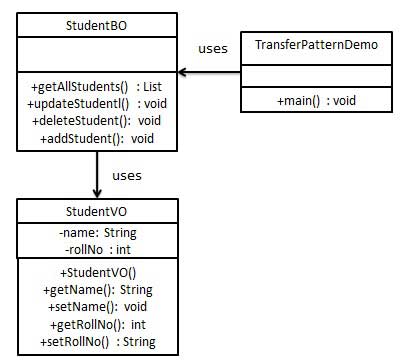【设计模式】传输对象模式(Transfer Object Pattern)
来源:互联网 发布:哪些是人工智能股票 编辑:程序博客网 时间:2024/06/11 09:52
传输对象模式
传输对象模式(Transfer Object Pattern)用于从客户端向服务器一次性传递带有多个属性的数据。传输对象也被称为数值对象。传输对象是一个具有 getter/setter 方法的简单的 POJO 类,它是可序列化的,所以它可以通过网络传输。它没有任何的行为。服务器端的业务类通常从数据库读取数据,然后填充 POJO,并把它发送到客户端或按值传递它。对于客户端,传输对象是只读的。客户端可以创建自己的传输对象,并把它传递给服务器,以便一次性更新数据库中的数值。以下是这种设计模式的实体。
- 业务对象(Business Object) - 为传输对象填充数据的业务服务。
- 传输对象(Transfer Object) - 简单的 POJO,只有设置/获取属性的方法。
- 客户端(Client) - 客户端可以发送请求或者发送传输对象到业务对象。
实现
我们将创建一个作为业务对象的 StudentBO 和作为传输对象的 StudentVO,它们都代表了我们的实体。
TransferObjectPatternDemo,我们的演示类在这里是作为一个客户端,将使用 StudentBO 和 Student 来演示传输对象设计模式。

步骤 1
创建传输对象。
StudentVO.java
public class StudentVO { private String name; private int rollNo; StudentVO(String name, int rollNo){ this.name = name; this.rollNo = rollNo; } public String getName() { return name; } public void setName(String name) { this.name = name; } public int getRollNo() { return rollNo; } public void setRollNo(int rollNo) { this.rollNo = rollNo; }}
步骤 2
创建业务对象。
StudentBO.java
import java.util.ArrayList;import java.util.List;public class StudentBO { //列表是当作一个数据库 List<StudentVO> students; public StudentBO(){ students = new ArrayList<StudentVO>(); StudentVO student1 = new StudentVO("Robert",0); StudentVO student2 = new StudentVO("John",1); students.add(student1); students.add(student2); } public void deleteStudent(StudentVO student) { students.remove(student.getRollNo()); System.out.println("Student: Roll No " + student.getRollNo() +", deleted from database"); } //从数据库中检索学生名单 public List<StudentVO> getAllStudents() { return students; } public StudentVO getStudent(int rollNo) { return students.get(rollNo); } public void updateStudent(StudentVO student) { students.get(student.getRollNo()).setName(student.getName()); System.out.println("Student: Roll No " + student.getRollNo() +", updated in the database"); }}
步骤 3
使用 StudentBO 来演示传输对象设计模式。
TransferObjectPatternDemo.java
public class TransferObjectPatternDemo { public static void main(String[] args) { StudentBO studentBusinessObject = new StudentBO(); //输出所有的学生 for (StudentVO student : studentBusinessObject.getAllStudents()) { System.out.println("Student: [RollNo : " +student.getRollNo()+", Name : "+student.getName()+" ]"); } //更新学生 StudentVO student =studentBusinessObject.getAllStudents().get(0); student.setName("Michael"); studentBusinessObject.updateStudent(student); //获取学生 studentBusinessObject.getStudent(0); System.out.println("Student: [RollNo : " +student.getRollNo()+", Name : "+student.getName()+" ]"); }}
步骤 4
验证输出。
Student: [RollNo : 0, Name : Robert ]Student: [RollNo : 1, Name : John ]Student: Roll No 0, updated in the databaseStudent: [RollNo : 0, Name : Michael ]
阅读全文
0 0
- 【设计模式】传输对象模式(Transfer Object Pattern)
- Java Transfer Object Pattern(传输对象模式)
- 设计模式学习—传输对象模式(Transfer Object Design Pattern)
- 设计模式:空对象模式(Null Object Pattern)
- 【设计模式】空对象模式(Null Object Pattern)
- [翻译]空对象设计模式(Null Object Design Pattern)
- 设计模式 一 值对象模式(The Value Object Pattern)
- 空对象模式(Null Object Pattern)
- 被遗忘的设计模式——空对象模式(Null Object Pattern)
- 被遗忘的设计模式——空对象模式(Null Object Pattern)
- Java设计模式——空对象模式(Null Object Pattern)
- 设计模式(32)--传输对象模式
- Java 空对象设计模式(Null Object Pattern) 讲解
- 设计模式-传输对象
- 【CDP-云设计模式】第6章,3.直接对象上传模式(Direct Object Upload Pattern)
- 主动对象模式(Active Object pattern)
- Java Null Object Pattern(空对象模式)
- 设计模式学习—空对象模式(Null Object Design Pattern)
- 字符串数组中两个字符串的最小距离
- <!DOCTYPE html>很重要
- c++的左值与右值 ,const限定符--随笔
- 仿微信添加标签效果
- Eclipse中切换svn账号
- 【设计模式】传输对象模式(Transfer Object Pattern)
- git 查看远程分支、本地分支、创建分支、把分支推到远程repository、删除本地分支
- 【HTML+CSS】教你切图篇5-星星评分纯CSS实现
- anaconda navigator闪退问题解决
- fread
- 貌似淘宝下拉PopWindow筛选【动画、列表、位置】
- MD5加密工具类(16/32位加密算法)
- 【设计模式】访问者模式(Visitor Pattern)
- Linux下,qt5中使用Qt Multimedia编译时遇到报错


